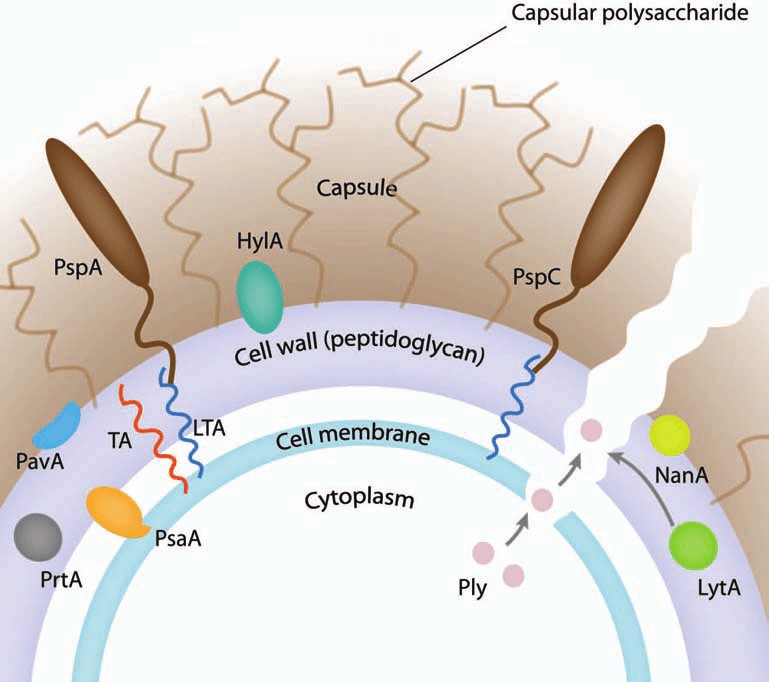Streptococcus pneumoniae (Pneumococcus) is a gram-positive, encapsulated, facultative anaerobic, lancet-shaped coccus, which is responsible for severe infections, causing millions of deaths yearly. On the surface of Streptococcus pneumoniae, there are three major surface layers: plasma membrane, cell wall, and polysaccharides capsule.
 Fig. 1 Schematic representation of the major virulence factors of S. pneumoniae (Nieto PA, et al. 2013)
Fig. 1 Schematic representation of the major virulence factors of S. pneumoniae (Nieto PA, et al. 2013)
Polysaccharides capsule is the dominant surface structure of Streptococcus pneumoniae and plays a critical role in defense against the host immune system. To date, more than 90 different serotypes, divided into 25 individual types and 21 serogroups, each composed of two to eight serotypes with related capsular antigenic determinants, have been identified. There is considerable cross-reactivity among certain of the 90 recognized serotypes, and a single antigen may provide protection against several types within a given serogroup.
Since protection against pneumococcal infection is mediated by immunoglobulin G (IgG) antibodies specific to the capsular polysaccharide serotype, an ELISA that measures IgG levels is used in the evaluation of pneumococcal vaccines as a surrogate assay. In 2000, the World Health Organization (WHO) provided a laboratory guideline for ELISA to quantify IgG antibodies specific for S. pneumoniae CPSs in human serum.
Applications
- Preabsorption of CWPSs-specific antibodies to minimize non-CPS-specific binding signals
- ELISA plate-binding assay for quantitation of S. pneumoniae serotype specific IgG
DAG2685 Product Parameters
- Format: Liyophilized
- Polysaccharide content: 5.925 mg/mL
- Endotoxin content:<0.625 EU/mL
- Turbidity: 1,394 mg/mL
Product List
References
- Paton JC, et al. (2019). Streptococcus pneumoniae Capsular Polysaccharide. Microbiology Spectrum. 7(2).
- Goldblatt D, et al. (1992). Role of cell wall polysaccharide in the assessment of IgG antibodies to the capsular polysaccharides of Streptococcus pneumoniae in childhood. The Journal of Infectious Diseases. 166(3):632-634.
- Nieto PA, et al. (2013). Gene elements that regulate Streptococcus pneumoniae virulence and immunity evasion. Current Gene Therapy. 13(1):51-64.
- Lee H, et al. (2017). Validation of the World Health Organization Enzyme-Linked Immunosorbent Assay for the Quantitation of Immunoglobulin G Serotype-Specific Anti-Pneumococcal Antibodies in Human Serum. Journal of Korean Medical Science. 32(10):1581-1587.